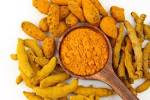
06 Apr Healthiest Foods You May Not Be Eating – Yet
Writing for Details, Lisa Silva put together a short list of “The 7 Healthiest Foods You Aren’t Eating (Yet).”

The spice turmeric is a powerhouse. Anti-inflammatory compounds like curcumin, which may treat conditions like asthma, heart disease, and cancer. Top of the list of seven must-consume.
Let’s rethink your grocery list. Sure, you gulp bone broth by the gallon and eat kale like there’s no tomorrow—but the real nutritional powerhouses might just be the ones you haven’t tried yet. Below, seven new superfoods to know, love, and juice.
Sauerkraut
In Brief: Antioxidants and essential vitamins, plus plant-based probiotics
The Lowdown: Cabbage alone is quite the powerhouse. It has half your daily recommended vitamin C and all of your recommended vitamin K, not to mention choline, beta-carotene, and 3,3′-diindolymethane (DIM), a compound shown to prevent cancer and protect healthy tissue during radiation therapy. Turn that cabbage into sauerkraut, though, and it’ll also pack a probiotic punch: “The fermentation process is essential,” says dietitian Leah Mark, M.S., C.D.N., C.P.T. “Sauerkraut and most fermented products are going to have beneficial bacteria that aid not only in digestion but also in treating inflammation in the body.” That’s good news for those who don’t eat dairy: The probiotics in sauerkraut will help maintain gut balance and a healthy immune system—no Jamie Lee Curtis–approved yogurt required.
How to Eat It: So why not just stock up on probiotic supplements? “Bacteria in the gut actually need fiber to help them thrive and create the beneficial effects that they do,” Mark says. Be sure to pick up raw, unpasteurized sauerkraut, or whip up a batch yourself—it makes for a genius sandwich topping.Watercress
In Brief: The whole package—calcium, fiber, and protein, plus antioxidants like vitamin C and beta-carotene
The Lowdown: There’s a reason this humble leaf ranks first among powerhouse vegetables. Sure, it’s got the usual suspects, including vitamins A and C, but here’s the kicker: Watercress also packs a healthy dose of calcium—plus the vitamin K you need to absorb it—as well as fiber and protein, earning it a perfect score on the nutrient-density scale. (Kale, by contrast, has just under 50/100.) Still not convinced? Research published in the American Journal of Clinical Nutrition indicates that adults who consumed watercress saw less DNA damage and higher levels of antioxidants in the body.
How to Eat It: Like arugula, watercress makes a peppery, flavorful salad—but it’s just as delicious in a hot or chilled soup.Seaweed
In Brief: Antioxidants and iodine, an essential element for thyroid health
The Lowdown: You know that expensive, all-natural Himalayan salt you just bought? Turns out, it might not be so good for you. “As people are staying away from iodized salt and moving toward sea salt, we’re seeing more iodine deficiencies,” Mark says. If you’re often tired or experiencing weight gain, it might be time to step up your iodine levels—and that’s where seaweed comes in. It’s high in not only iodine content but also in free-radical-fighting antioxidants, which gives you another reason to hit the sushi bar.
How to Eat It: Step away from the seaweed salad, which can have up to a third of your recommended daily intake of sodium. Opt for crispy nori snacks—or, if you can’t stand the taste, slather some seaweed on your skin instead. It’ll fight the aging process from the outside.Sesame Seeds…


Sorry, the comment form is closed at this time.